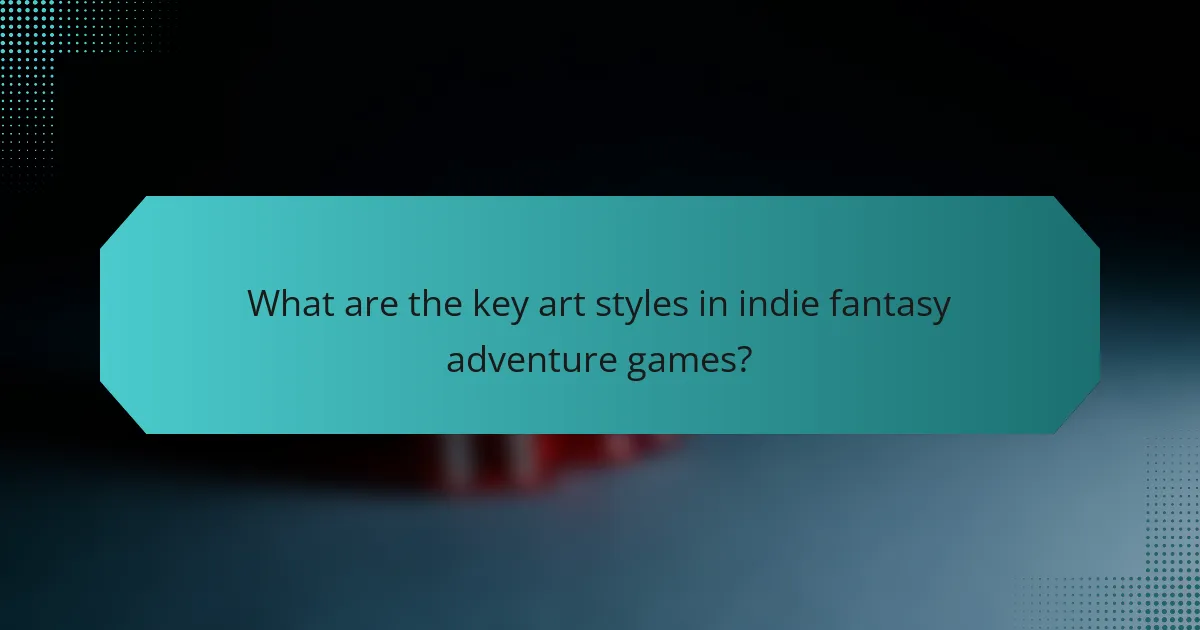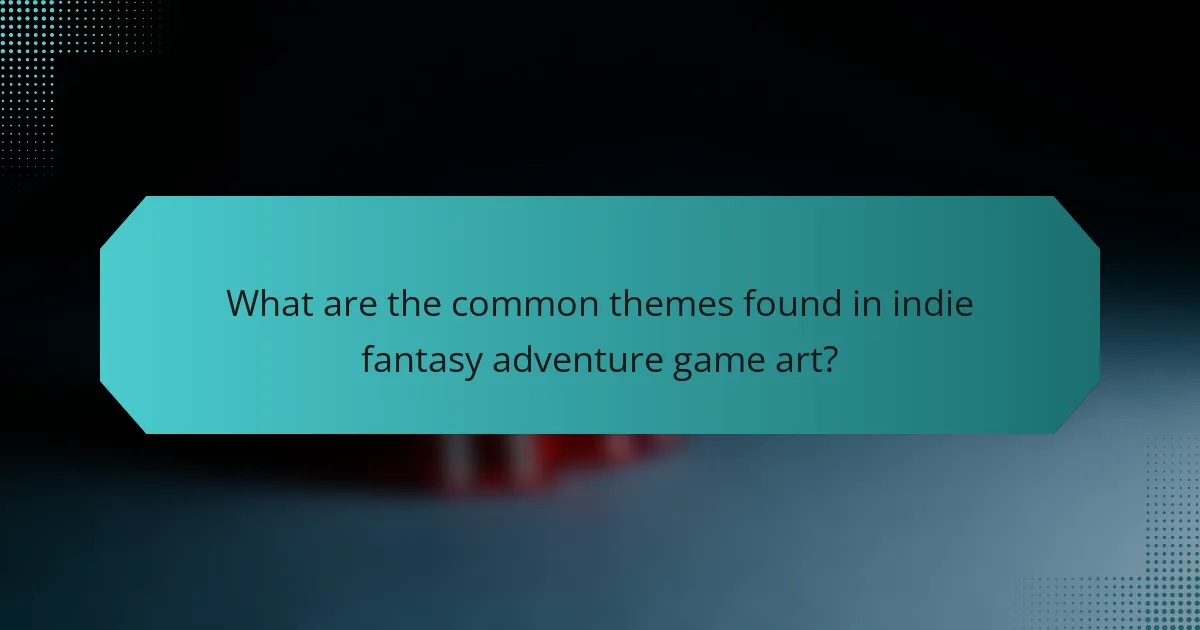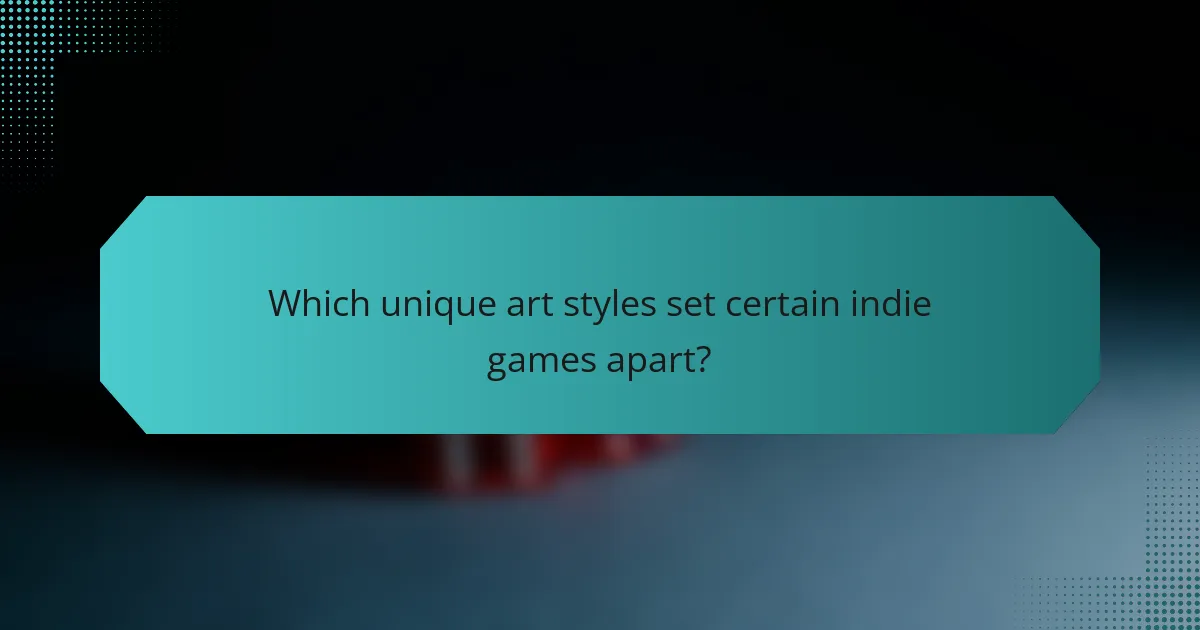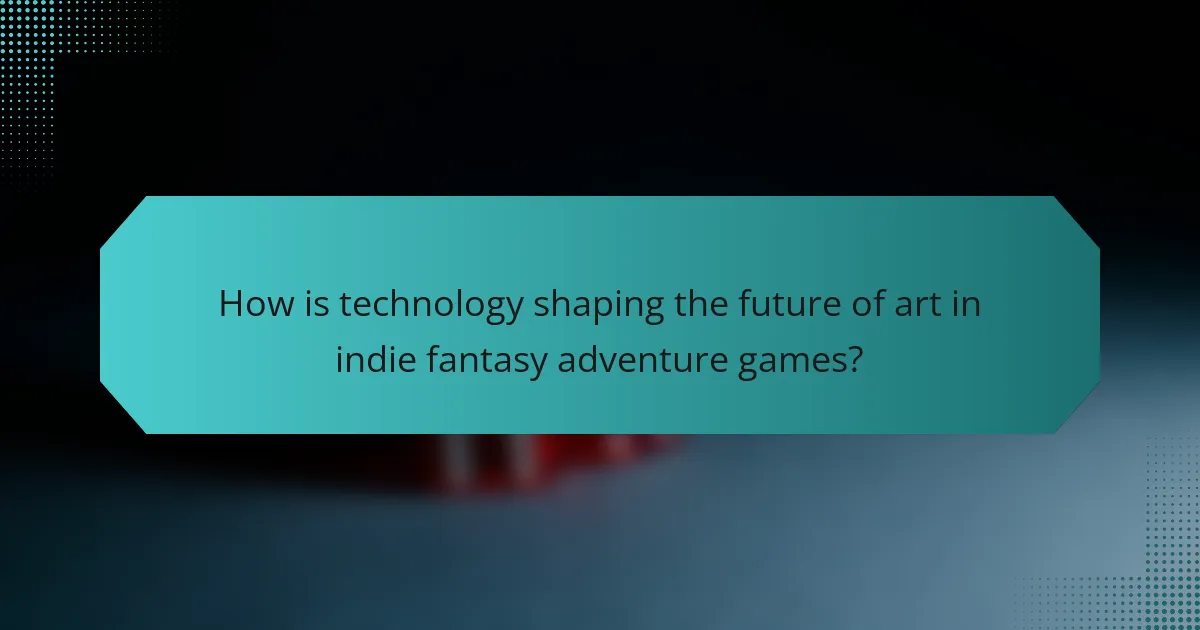Indie fantasy adventure games feature diverse art styles that enhance player immersion and storytelling. Key styles include pixel art, hand-painted visuals, and low-poly designs. Cultural influences draw from folklore and mythology, shaping character design and environmental aesthetics. Technological advancements allow for innovative techniques, making unique artistic expression more accessible to indie developers.

What are the key art styles in indie fantasy adventure games?
Indie fantasy adventure games showcase diverse art styles, each reflecting unique trends and cultural influences. Key styles include pixel art, which evokes nostalgia and simplicity; hand-painted visuals, offering rich textures and depth; and low-poly designs, emphasizing minimalism and charm. Additionally, 2D and 3D hybrid styles merge techniques for innovative gameplay experiences. Cultural influences often draw from folklore, mythology, and regional aesthetics, enriching the narrative and visual storytelling. These art styles not only enhance immersion but also define the identity of indie titles in the gaming landscape.
How do traditional art influences shape modern indie games?
Traditional art influences significantly shape modern indie games by inspiring unique visual styles and narrative techniques. Indie developers often draw from diverse cultural art forms, integrating them into game aesthetics. This results in visually rich environments that reflect historical and cultural narratives. For example, pixel art and hand-drawn illustrations evoke nostalgia while providing a canvas for storytelling. Moreover, traditional art techniques, such as watercolor and collage, are increasingly used to create immersive experiences. These influences enable indie games to stand out in a crowded market, offering players a blend of innovation and familiarity.
Which contemporary techniques are prevalent in indie game art?
Contemporary techniques prevalent in indie game art include pixel art, hand-drawn visuals, and 3D low-poly designs. These styles emphasize creativity and individuality, often influenced by cultural aesthetics. For example, pixel art allows for nostalgic gameplay experiences while hand-drawn visuals enhance storytelling. Additionally, unique color palettes and experimental animations are common, showcasing the diversity in indie game development.

How do cultural narratives influence art styles in indie games?
Cultural narratives significantly shape art styles in indie fantasy adventure games by infusing them with unique visual elements and storytelling techniques. These narratives draw from folklore, mythology, and cultural history, influencing character design, color palettes, and environmental aesthetics. For example, games inspired by Eastern folklore often feature vibrant colors and intricate patterns, while those influenced by Western mythology may emphasize darker themes and more subdued tones. As a result, the cultural context enriches the gameplay experience, making it more immersive and relatable to players.
What role does folklore play in shaping visual aesthetics?
Folklore significantly influences visual aesthetics in indie fantasy adventure games by providing rich cultural narratives and motifs. These games often incorporate traditional stories, symbols, and characters that resonate with players, enhancing immersion. Unique attributes of folklore, such as mythical creatures and legendary heroes, shape character designs and environments, creating distinct artistic styles. As a result, the visual representation becomes a blend of cultural heritage and imaginative expression, appealing to diverse audiences.
How do regional art movements impact game design choices?
Regional art movements significantly influence game design choices by shaping visual aesthetics and narrative themes. For instance, the vibrant colors of Latin American art often translate into bright, fantastical environments in indie games. Similarly, Japanese art movements inspire minimalist design and intricate storytelling, impacting gameplay mechanics. These cultural influences create unique gaming experiences that resonate with players’ emotions and cultural backgrounds. As a result, indie developers leverage these art styles to enhance immersion and player engagement.

What are the common themes found in indie fantasy adventure game art?
Common themes in indie fantasy adventure game art include vibrant colors, whimsical character designs, and immersive landscapes. Many games draw inspiration from folklore and mythology, creating unique visual narratives. Techniques often involve hand-drawn aesthetics and pixel art, emphasizing a personal touch. Cultural influences shape the art, reflecting diverse storytelling traditions and artistic styles.
How do color palettes affect player immersion?
Color palettes significantly enhance player immersion by influencing emotional responses and environmental storytelling. Warm colors can create a sense of adventure, while cooler tones may evoke tranquility. This impact is evident in indie fantasy adventure games, where unique art styles often utilize specific palettes to reflect cultural themes and narrative depth. For instance, vibrant colors may represent fantastical elements, enhancing the player’s connection to the game world. Additionally, contrasting colors can guide player focus, directing attention to important gameplay elements. Overall, effective color palettes are crucial in crafting immersive experiences that resonate with players.
What visual storytelling techniques enhance gameplay experience?
Visual storytelling techniques that enhance gameplay experience include unique art styles, immersive environments, and character design. These elements create emotional connections and convey narrative depth. For example, stylized graphics can evoke specific moods, while detailed backgrounds enrich the world-building. Cultural influences, such as folklore, further enhance the storytelling, providing players with relatable themes and symbols.

Which unique art styles set certain indie games apart?
Unique art styles in indie fantasy adventure games often include hand-drawn aesthetics, pixel art, and surreal visuals. These styles set games apart by enhancing storytelling and player immersion. For example, hand-drawn art can evoke a whimsical atmosphere, while pixel art may tap into nostalgia. Surreal visuals often challenge perceptions and create unique experiences. Cultural influences also play a significant role, as many indie developers draw inspiration from folklore and mythology, enriching the game’s visual narrative.
What are the standout examples of experimental art in indie games?
Standout examples of experimental art in indie games include “Journey,” “Gris,” and “Oxenfree.” These games showcase innovative visual styles that enhance storytelling and emotional engagement. “Journey” features stunning landscapes and a unique art style that conveys a sense of wonder. “Gris” uses a watercolor aesthetic to reflect the protagonist’s emotional journey. “Oxenfree” combines vibrant colors with a graphic novel-inspired approach, creating an immersive atmosphere. Each game exemplifies how artistic choices can redefine player experiences in indie fantasy adventure games.
How do personal artistic visions manifest in game design?
Personal artistic visions manifest in game design through unique art styles that reflect individual creativity. Indie fantasy adventure games often showcase diverse visual aesthetics influenced by cultural themes, narrative elements, and innovative techniques. Artists experiment with color palettes, character designs, and environments to create immersive worlds. These artistic choices enhance player engagement and emotional connection, making the game experience distinct and memorable. The integration of personal vision fosters originality, setting indie titles apart from mainstream games.

What are the challenges faced by artists in the indie game scene?
Indie game artists face significant challenges, including limited budgets, resource constraints, and competition. These factors hinder their ability to experiment with diverse art styles and innovative techniques. The cultural influences in indie fantasy adventure games often reflect personal narratives, yet artists struggle to balance originality with market expectations. Additionally, the evolving technology landscape demands continuous learning, which can be overwhelming for small teams.
How does budget impact artistic expression in indie games?
Budget significantly influences artistic expression in indie games by limiting resources and shaping creative choices. Smaller budgets often lead to unique art styles, as developers focus on innovative techniques and cultural influences to maximize impact. For example, pixel art and minimalist designs are prevalent, allowing developers to convey rich narratives with fewer resources. Additionally, cultural influences often inspire these artistic choices, reflecting diverse backgrounds and perspectives within the indie game community. This interplay between budget constraints and creativity fosters a distinctive aesthetic that characterizes many indie fantasy adventure games.
What are the common misconceptions about indie game art?
Many misconceptions exist about indie game art, often undervaluing its complexity and diversity. One common myth is that indie art lacks professionalism, while many indie titles feature high-quality, innovative designs. Another misconception is that all indie art is pixelated; however, styles range from hand-drawn to 3D rendering. Additionally, some believe indie art is solely driven by budget constraints, but many developers prioritize artistic vision and cultural influences. Lastly, the idea that indie games have limited appeal overlooks their unique storytelling and emotional depth, which can resonate widely.

How is technology shaping the future of art in indie fantasy adventure games?
Technology is revolutionizing art in indie fantasy adventure games by enhancing creativity and accessibility. Digital tools allow artists to experiment with diverse styles, blending traditional techniques with modern aesthetics. For instance, procedural generation enables unique landscapes and characters, fostering innovation. Additionally, platforms like Unreal Engine and Unity provide resources for high-quality visuals, making advanced art techniques more accessible to indie developers. As a result, cultural influences from various backgrounds are more easily incorporated, enriching the game’s artistic expression.
What tools are essential for indie game artists today?
Essential tools for indie game artists today include digital art software, 3D modeling applications, and game engines. Popular choices are Adobe Photoshop for 2D art, Blender for 3D modeling, and Unity or Unreal Engine for game development. These tools support diverse art styles, enabling artists to create immersive fantasy worlds. Additionally, collaboration platforms like Trello or Discord facilitate teamwork and project management, enhancing the creative process.
How do emerging technologies influence artistic trends?
Emerging technologies significantly influence artistic trends in indie fantasy adventure games by enhancing creativity and interactivity. Techniques such as procedural generation allow for unique environments, while virtual reality immerses players in rich narratives. Additionally, advancements in graphics technology lead to more vibrant and detailed art styles, reflecting cultural influences. For instance, the integration of AI in character design enables artists to explore new aesthetics and storytelling methods. This fusion of technology and artistry creates a dynamic landscape where innovation drives artistic expression.

What best practices can indie developers adopt for effective art direction?
Indie developers can enhance art direction by embracing distinct visual styles, leveraging cultural influences, and applying innovative techniques. Focusing on a cohesive aesthetic helps create immersive experiences.
Key practices include:
1. Researching current trends in fantasy art to inspire unique designs.
2. Experimenting with color palettes to evoke specific emotions.
3. Incorporating cultural elements to enrich storytelling.
4. Utilizing stylized character designs to differentiate from mainstream titles.
5. Collaborating with artists to refine vision and execution.
These strategies foster creativity and ensure that the game’s art resonates with players.
How can collaboration enhance artistic outcomes in game development?
Collaboration significantly enhances artistic outcomes in game development by combining diverse perspectives and skill sets. This synergy fosters innovative art styles, allowing for richer visual storytelling in indie fantasy adventure games. Collaborative techniques, such as iterative feedback and co-creation, lead to unique artistic expressions that reflect various cultural influences. As a result, the final product often showcases a blend of techniques that resonate with a broader audience.
What are the common pitfalls to avoid in indie game art creation?
Common pitfalls in indie game art creation include neglecting consistency, overcomplicating designs, ignoring player feedback, and underestimating the importance of cultural influences. Consistency in art style enhances immersion, while simplicity often leads to clearer communication of concepts. Player feedback is crucial for refining visuals, and understanding cultural influences can enrich the game’s narrative and aesthetic. Avoiding these pitfalls can significantly improve the overall quality and reception of the game.